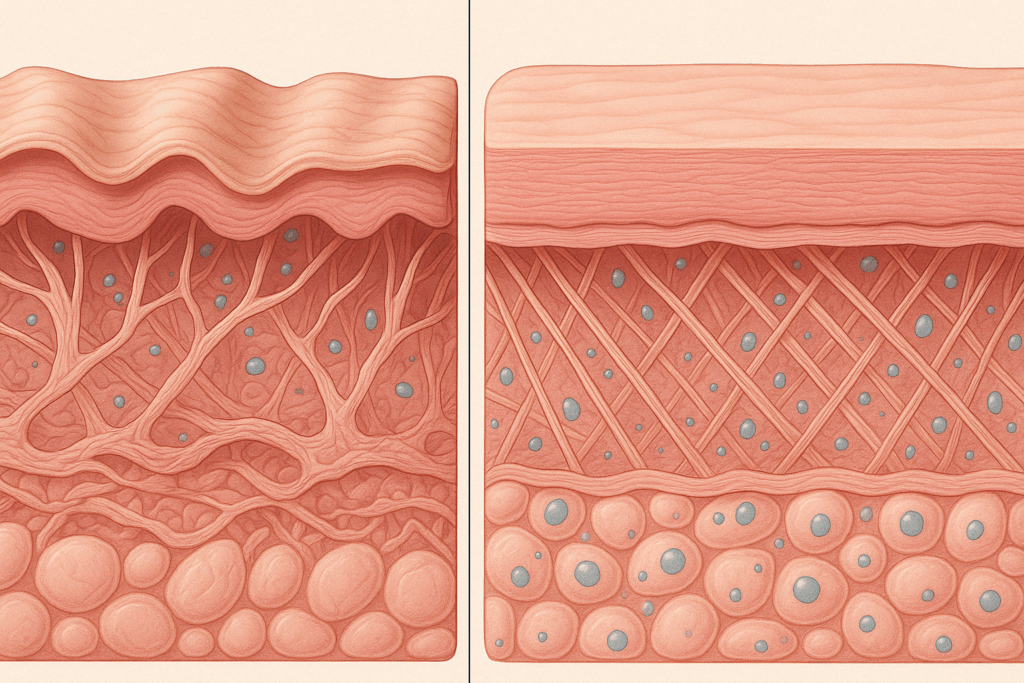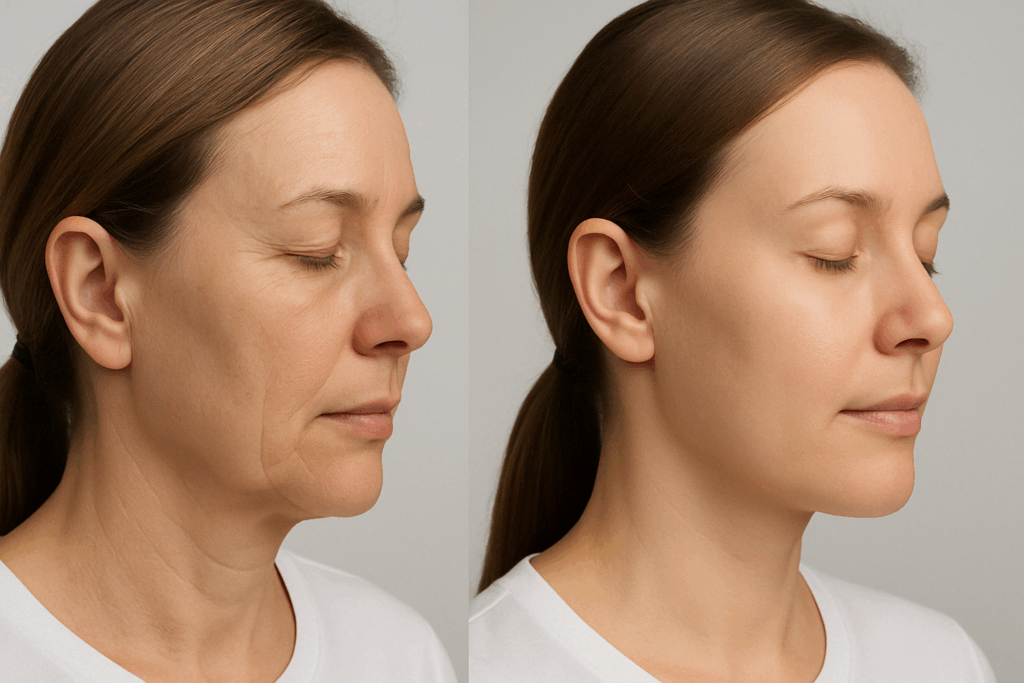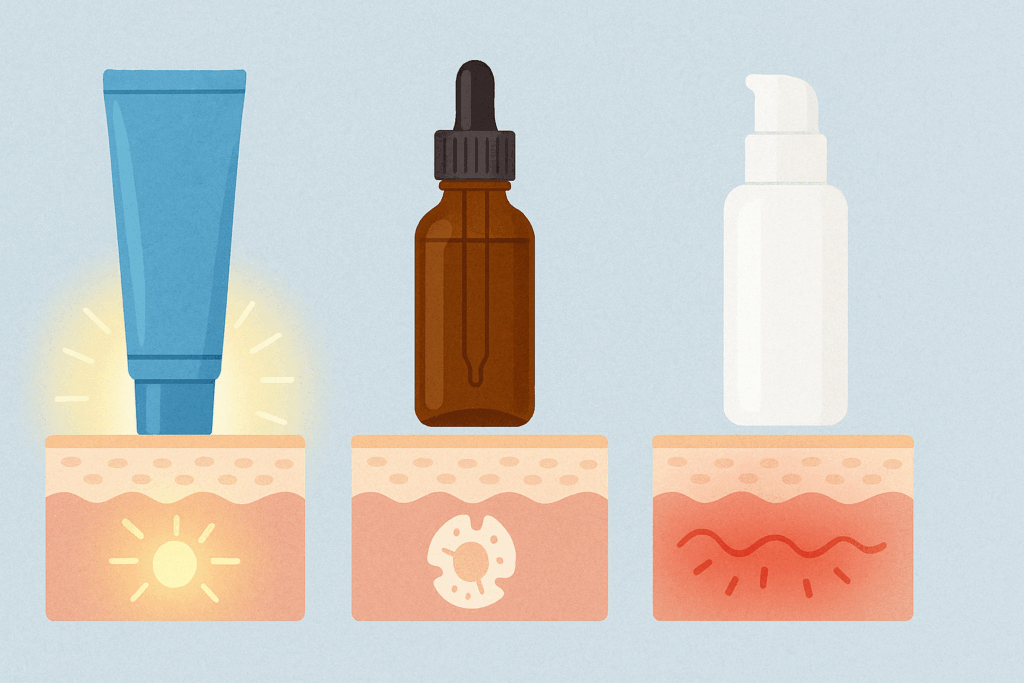In the ever-evolving landscape of skin care, consumers continue to seek solutions that are not only effective but also backed by credible science. Among the numerous products marketed for anti-aging benefits, Differin (adapalene) has gained increasing attention for its potential to reduce fine lines and wrinkles. Originally approved as an acne treatment, Differin’s repositioning in the realm of anti-aging has sparked curiosity among dermatologists, researchers, and consumers alike. But is Differin good for wrinkles? Does the clinical science support its use for smoothing skin and reducing signs of aging? To answer these questions, we must delve into the pharmacology, clinical research, dermatological consensus, and real-world applications of Differin for anti-aging purposes.
You may also like: How to Choose Skin Care for Fine Lines: Evidence-Based Tips for Healthier, Younger-Looking Skin

Understanding What Differin Is and How It Works
Differin, whose active ingredient is adapalene, is a third-generation synthetic retinoid belonging to the same family of compounds as tretinoin and retinol. Retinoids, derivatives of vitamin A, are renowned for their role in regulating cell turnover, stimulating collagen production, and improving overall skin texture. Differin works by binding to specific retinoic acid receptors in the skin, influencing cellular differentiation and desquamation, which helps clear clogged pores and reduce inflammation.
Unlike earlier-generation retinoids, adapalene is chemically stable, less irritating, and more selective in its receptor binding. This makes it an ideal candidate for long-term use, even in individuals with sensitive skin. While Differin was originally developed for acne vulgaris due to its ability to prevent comedones and reduce inflammatory lesions, researchers began to observe its ancillary benefits, including improvements in hyperpigmentation, fine lines, and overall skin smoothness. These early observations formed the basis of further inquiry into whether Differin for anti-aging might be a viable and evidence-supported intervention.

The Mechanisms Behind Anti-Aging Effects of Retinoids
Retinoids influence skin aging at the cellular and molecular levels. As skin ages, it undergoes structural and functional changes: collagen production declines, elastin fibers degrade, epidermal turnover slows, and moisture retention diminishes. These changes result in wrinkles, sagging, and a rough or uneven skin texture. Retinoids like adapalene address these issues through multiple biological mechanisms.
Firstly, retinoids enhance dermal collagen synthesis while simultaneously inhibiting matrix metalloproteinases (MMPs), enzymes that break down collagen. By doing so, retinoids help preserve and restore dermal architecture. Secondly, they accelerate epidermal turnover, encouraging the shedding of old, damaged cells and the proliferation of new keratinocytes. This leads to smoother, more radiant skin. Finally, retinoids improve skin hydration and elasticity by enhancing glycosaminoglycan production. Understanding these effects provides foundational insight into why using Differin for anti-aging may produce tangible benefits over time.

What the Research Says: Is Differin Good for Wrinkles?
A growing body of clinical literature suggests that adapalene, the active ingredient in Differin, offers measurable improvements in photoaged skin. One of the most cited studies in this area is a randomized, double-blind, placebo-controlled trial that evaluated the efficacy of 0.3% adapalene gel in subjects with moderate to severe photodamage. Over a 24-week period, participants who applied Differin demonstrated statistically significant improvements in fine lines, pigmentation irregularities, and overall skin tone compared to the control group.
Another study published in the Journal of Drugs in Dermatology found that consistent application of adapalene led to improvements in skin roughness, fine wrinkling, and tone uniformity. Importantly, these changes were not merely subjective impressions. Histological analysis confirmed increased collagen deposition and epidermal thickness—objective markers of anti-aging efficacy. These findings provide a compelling answer to the question: will Differin help wrinkles? For many individuals, particularly those seeking accessible and dermatologist-recommended options, the evidence supports its use as part of a comprehensive anti-aging routine.

How Differin Compares to Other Retinoids in Anti-Aging
When evaluating Differin for anti-aging, it’s essential to consider how it stacks up against other retinoids, especially tretinoin and over-the-counter retinol. Tretinoin, a prescription-strength retinoid, is widely regarded as the gold standard in anti-aging dermatology. It has decades of robust research backing its ability to reduce fine lines, stimulate collagen, and reverse photodamage. However, tretinoin is also notorious for causing skin irritation, dryness, and peeling—particularly during the initial adjustment phase known as retinization.
In contrast, Differin offers a more tolerable profile. Its molecular structure enables selective receptor binding, reducing the incidence of side effects while preserving many of the benefits associated with retinoid therapy. While adapalene may be slightly less potent than tretinoin in terms of collagen stimulation, it remains effective for long-term maintenance and is better tolerated by individuals with sensitive or reactive skin. Compared to retinol, which requires conversion into retinoic acid within the skin, Differin acts more directly and consistently. Thus, while the anti-aging effects of Differin may not be as rapid or pronounced as those of stronger retinoids, they are clinically significant and more sustainable for regular use.
Benefits Beyond Wrinkle Reduction
While many individuals turn to Differin for wrinkle reduction, its benefits extend beyond fine lines. Adapalene has demonstrated efficacy in improving overall skin tone, texture, and radiance. By promoting even cell turnover, Differin helps fade hyperpigmentation, reduce post-inflammatory discoloration, and prevent the formation of new blemishes. These secondary effects contribute to a more youthful and luminous complexion—an outcome often sought in anti-aging skin care.
Additionally, Differin’s anti-inflammatory properties make it suitable for managing subclinical skin inflammation, which is increasingly recognized as a contributor to skin aging. Chronic low-level inflammation accelerates collagen breakdown and impairs skin barrier function. By reducing inflammatory mediators, adapalene helps preserve skin integrity over time. This multidimensional approach adds further weight to the argument that Differin for anti-aging is not merely a marketing trend but a science-supported choice.

Practical Guidance for Using Differin in an Anti-Aging Routine
Integrating Differin into an anti-aging regimen requires thoughtful application and realistic expectations. Most dermatologists recommend starting with a pea-sized amount applied to clean, dry skin once daily, ideally in the evening. Because retinoids increase cellular turnover, they can initially cause dryness, peeling, and sensitivity—a phenomenon known as retinization. To mitigate these effects, users may apply a gentle moisturizer after Differin or use the product every other night during the first few weeks.
Sun protection is non-negotiable when using retinoids. Differin increases the skin’s sensitivity to ultraviolet (UV) radiation, making daily use of a broad-spectrum sunscreen essential. Skipping this step can lead to increased photodamage, offsetting the product’s benefits. Patience is also critical. While some users may observe textural improvements within a few weeks, visible reductions in fine lines and wrinkles typically emerge after 8 to 12 weeks of consistent use. Differin is not a quick fix; rather, it is a long-term investment in skin health.
Addressing Common Misconceptions About Differin and Aging Skin
A persistent misconception is that Differin is only appropriate for acne-prone teenagers and not suited for mature skin. This belief likely stems from its original FDA approval as an acne treatment. However, emerging research and clinical experience have expanded its role far beyond adolescent breakouts. In fact, dermatologists increasingly recommend Differin for patients in their 30s, 40s, and beyond who are seeking non-invasive options for managing early signs of aging.
Another misconception is that using Differin for anti-aging requires a prescription or dermatologist oversight. While stronger concentrations of adapalene, such as 0.3%, are prescription-based, the 0.1% gel is available over-the-counter and is sufficiently effective for many users. This accessibility allows broader populations to benefit from science-backed skin care without the barriers of medical appointments or insurance limitations. Still, users with significant skin concerns or comorbid dermatological conditions should consult a healthcare provider to ensure safe and appropriate use.
Who Should Consider Using Differin for Anti-Aging?
Differin can be an excellent option for individuals with early signs of photoaging, uneven skin tone, and textural irregularities. It is especially suitable for those who have not tolerated other retinoids due to irritation or sensitivity. Its gentle yet effective mechanism makes it ideal for those embarking on their first retinoid regimen. Moreover, Differin may appeal to budget-conscious consumers seeking clinically validated results without the high cost of boutique anti-aging products or cosmetic procedures.
However, Differin is not a one-size-fits-all solution. Individuals with extremely dry or eczema-prone skin may find adapalene too irritating, even with gradual introduction. Pregnant or breastfeeding individuals should avoid retinoids altogether, as they are not considered safe during these periods. Additionally, Differin should be used with caution in combination with other active ingredients such as alpha hydroxy acids (AHAs), beta hydroxy acids (BHAs), or vitamin C, which may amplify irritation. Tailoring the regimen to one’s skin type, sensitivity, and aesthetic goals is critical for achieving optimal results.

Realistic Expectations: What Differin Can and Cannot Do
It is important to approach Differin with informed expectations. While adapalene is effective in improving fine lines and promoting smoother skin, it is not a miracle cure for deep wrinkles or advanced photodamage. For more pronounced aging concerns, dermatological interventions such as laser resurfacing, microneedling, or injectable treatments may be required. Differin should be viewed as a preventive and maintenance tool—a way to slow the progression of aging, improve skin clarity, and preserve youthful features over time.
The benefits of Differin are cumulative and require ongoing commitment. Discontinuing use often results in a gradual return to baseline skin conditions. As with many aspects of skin care, consistency and patience are essential. While Differin may not deliver dramatic transformations overnight, its subtle, science-driven improvements can be significant when integrated into a comprehensive approach to skin health.
The Verdict: Will Differin Help Wrinkles?
Based on current evidence, the answer is a cautious but confident yes. Differin, while initially developed for acne, possesses the pharmacological properties necessary to support its use in anti-aging skin care. Multiple clinical studies have shown its ability to reduce fine lines, improve tone and texture, and enhance dermal collagen synthesis—all key factors in the appearance of aged skin. Though it may not rival the strength of tretinoin or produce instant results, Differin represents a valuable tool in the anti-aging arsenal, particularly for those who prioritize tolerability, affordability, and long-term skin health.
For those still wondering, “is Differin good for wrinkles?” or “will Differin help wrinkles?”, the current scientific consensus affirms that adapalene has a meaningful role in reducing signs of skin aging. Its accessibility, relatively gentle nature, and robust scientific foundation make it an appealing option for a wide range of users.
Frequently Asked Questions: Differin for Anti-Aging and Wrinkle Reduction
1. Can Differin be combined with other anti-aging ingredients like peptides or niacinamide?
Yes, Differin can be paired with other anti-aging ingredients, but it requires a thoughtful layering strategy. Niacinamide, known for its barrier-supporting and anti-inflammatory properties, is particularly compatible with Differin and can reduce the irritation sometimes associated with retinoid use. Peptides, on the other hand, help stimulate collagen and can amplify Differin’s benefits for skin firmness and elasticity. When introducing Differin for anti-aging, it’s often best to apply Differin first, followed by a moisturizer containing niacinamide or peptides after allowing sufficient time for absorption. While Differin is good for wrinkles on its own, combining it with these ingredients may produce more comprehensive rejuvenation over time.
2. How does Differin affect skin with rosacea or redness-prone conditions?
Individuals with rosacea or chronic redness should approach Differin for anti-aging cautiously. Although adapalene is gentler than many other retinoids, it can still trigger flare-ups in sensitive skin types, especially in the initial weeks. For these individuals, a patch test is recommended, and Differin should be used no more than two to three times a week at first. Moisturizing before or after application can also help buffer the skin and reduce potential irritation. While Differin is good for wrinkles, its use in redness-prone skin must be carefully monitored and often adjusted based on individual tolerance.
3. Are there psychological benefits to starting Differin for anti-aging purposes?
Yes, engaging in a consistent skin care routine that includes Differin for anti-aging may yield psychological benefits beyond cosmetic improvements. Many users report feeling more in control of their aging process, which can enhance confidence and self-esteem. There’s also a therapeutic aspect to ritualized self-care that provides structure and a sense of agency, especially in midlife. Although the question “will Differin help wrinkles” focuses on physical outcomes, it’s worth noting that the visible skin improvements often translate into improved mood and perceived quality of life. This psychological reinforcement encourages long-term adherence and a more positive relationship with aging.
4. Is it safe to use Differin year-round, including during summer months?
Differin can be used safely year-round, but sun protection becomes even more crucial during summer. Because Differin increases skin sensitivity to UV rays, diligent application of broad-spectrum SPF 30 or higher is non-negotiable. Contrary to the myth that retinoids must be paused in summer, dermatologists often recommend continuing Differin for anti-aging through all seasons, provided that sun exposure is minimized and protection is maximized. Protective clothing, hats, and seeking shade during peak hours should become part of a broader sun-care strategy. Using Differin for anti-aging consistently—even through summer—ensures uninterrupted collagen support and long-term wrinkle reduction.
5. Does the texture of Differin matter when choosing a product for anti-aging?
Yes, the formulation texture can influence both tolerability and effectiveness when using Differin for anti-aging. The most commonly available OTC form is a 0.1% gel, which is lightweight and generally suited for oily to combination skin. However, some newer formulations, such as creams or lotions, are emerging to address the needs of drier or more mature skin. These versions often include emollients that reduce the drying effects of retinoids, making them more appropriate for aging skin. Choosing the right texture not only supports consistent use but also helps enhance results, particularly when the goal is to assess whether Differin is good for wrinkles in your unique skin type.
6. How long should someone wait before judging whether Differin is helping their wrinkles?
The timeline for seeing visible results varies, but most users require at least 8 to 12 weeks of consistent use to notice improvements in fine lines and texture. Collagen synthesis is a gradual process, and Differin for anti-aging works best when used regularly over several months. Some users may become discouraged during the initial adjustment phase due to dryness or breakouts—commonly called the purging phase—but this is often a sign the product is stimulating skin turnover. While Differin is good for wrinkles, its benefits emerge subtly and compound over time. Patience and adherence are critical for assessing long-term outcomes.
7. Can Differin prevent wrinkles from forming in the first place?
Yes, one of the most compelling aspects of Differin for anti-aging is its potential as a preventative treatment. By stimulating cell turnover and maintaining collagen production, Differin helps delay the breakdown of structural proteins that lead to wrinkle formation. Even individuals in their late 20s or early 30s are now being advised to consider preventive retinoid use, particularly if they have a history of sun exposure or premature aging in their family. The idea isn’t just about reversing damage—it’s about forestalling it. So, while people often ask, “will Differin help wrinkles that already exist?”, the more powerful question may be whether it can stop them from appearing in the first place—and research increasingly suggests that it can.
8. Is there a difference between Differin’s anti-aging performance on various ethnic skin tones?
Differin for anti-aging appears to be effective across a wide range of ethnicities, but skin tone may influence how side effects are perceived and managed. For example, individuals with deeper skin tones may be more prone to post-inflammatory hyperpigmentation if Differin causes irritation. To mitigate this, it’s crucial to prioritize skin-barrier repair and hydration while introducing Differin slowly. On the other hand, Differin is good for wrinkles regardless of skin tone because its molecular action is based on universal biological processes like collagen stimulation and epidermal renewal. Dermatologists recommend customized routines to ensure safety and efficacy for all racial and ethnic backgrounds.
9. What are some innovative ways dermatologists are using Differin off-label for aging skin?
Some dermatologists are exploring off-label uses of Differin beyond the face, applying it to the neck, décolletage, and even the backs of hands—areas often neglected but prone to photoaging. Because Differin for anti-aging is generally well-tolerated, it offers a safer alternative to harsher retinoids for these more delicate areas. Another emerging trend is using Differin in conjunction with microneedling or chemical exfoliation, under professional supervision, to increase its penetration and collagen-stimulating effects. These methods are not mainstream yet but reflect the growing interest in maximizing Differin’s anti-aging properties in creative, medically guided ways. As research evolves, so does the understanding of how Differin is good for wrinkles in places we may not initially think to treat.
10. How might Differin fit into future trends in anti-aging dermatology?
As the skin care industry increasingly focuses on evidence-based, minimalist routines, Differin is likely to remain central to future anti-aging strategies. The movement away from 10-step regimens toward streamlined, high-impact products aligns with Differin’s profile as a multi-functional treatment. Additionally, as AI and personalized dermatology platforms advance, tools that assess whether Differin will help wrinkles based on genetic and lifestyle factors may become available. We’re also seeing interest in pairing Differin with emerging biotech ingredients, such as topical exosomes and growth factors, to enhance its reparative capabilities. These innovations reinforce why Differin for anti-aging continues to hold clinical and consumer interest as skin science progresses.
Final Thoughts on Differin for Anti-Aging: A Science-Based Addition to Your Skin Care Strategy
Incorporating Differin into an anti-aging skin care routine is not only a practical decision but also one supported by dermatological science. While the product’s over-the-counter availability may tempt users to regard it as a casual cosmetic, its active ingredient—adapalene—is a potent retinoid with a proven track record of promoting healthier, more youthful-looking skin. Those seeking to reduce fine lines, even out skin tone, and maintain long-term skin resilience will likely find that Differin offers more than a cosmetic quick fix—it serves as a preventative and reparative treatment grounded in clinical research.
As with any skin care intervention, success with Differin depends on consistent use, realistic expectations, and proper support through moisturization and sun protection. When used appropriately, Differin for anti-aging delivers gradual, meaningful improvements that align with a holistic view of skin health. In an industry saturated with bold promises and fleeting trends, Differin stands out as a quiet but powerful ally in the pursuit of youthful, resilient skin. Whether you’re just beginning your anti-aging journey or refining an established routine, Differin may very well be the trusted retinoid you’ve been searching for.
Was this article helpful? Don’t let it stop with you. Share it right now with someone who needs to see it—whether it’s a friend, a colleague, or your whole network. And if staying ahead on this topic matters to you, subscribe to this publication for the most up-to-date information. You’ll get the latest insights delivered straight to you—no searching, no missing out.
Further Reading:
Adapalene (Differin) versus Tretinoin (Retin-A) for Wrinkles
Why Differin gel is one of the best anti-aging products
Recent Advances Regarding the Therapeutic Potential of Adapalene
Disclaimer
The information contained in this article is provided for general informational purposes only and is not intended to serve as medical, legal, or professional advice. While Health11News strives to present accurate, up-to-date, and reliable content, no warranty or guarantee, expressed or implied, is made regarding the completeness, accuracy, or adequacy of the information provided. Readers are strongly advised to seek the guidance of a qualified healthcare provider or other relevant professionals before acting on any information contained in this article. Health11News, its authors, editors, and contributors expressly disclaim any liability for any damages, losses, or consequences arising directly or indirectly from the use, interpretation, or reliance on any information presented herein. The views and opinions expressed in this article are those of the author(s) and do not necessarily reflect the official policies or positions of Health11News.